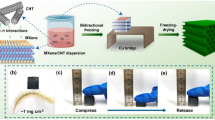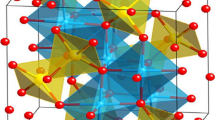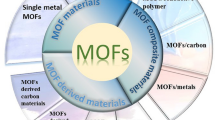Abstract
Novel nanorod-like manganese-based metal–organic frameworks (Mn-MOFs) were prepared through a facile solvothermal method using 1,3,5-benzentricarboxylic acid as organic linker and applied as electroactive material for supercapacitors. The Mn-MOFs exhibited a high-specific capacitance of 371 F g−1 at 0.5 A g−1 and an excellent rate capability even if the current density was promoted to 10 A g−1. Furthermore, the designed asymmetric supercapacitors with Mn-MOFs as cathode, graphene as anode and 6 mol L−1 KOH as electrolyte delivered a specific capacitance of 89 F g−1 in the working potential range of 0 to 1.6 V and the energy density can reach 31.6 Wh kg−1. Notably, the specific capacitance of the fabricated hybrid supercapacitors retained 91.8% of the initial capacitance after successive 10,000 charge–discharge cycles at a current density of 1 A g−1. These results suggest that the as-synthesized nanorod-shaped Mn-MOFs can act as promising electrode materials for high-performance supercapacitors.
Graphical abstract
Nanorod-like Mn-MOFs were prepared and investigated as promising electroactive nanomaterials for supercapacitors, which exhibited a high-specific capacitance of 371 F g-1, excellent rate capability and long cycle life with an eminent energy density of 31.6 Wh kg-1 for the designed Mn-MOFs//graphene supercapacitor.










Similar content being viewed by others
References
Wang G, Zhang L, Zhang J (2012) A review of electrode materials for electrochemical supercapacitors. Chem Soc Rev 41:797–828
Feng N, Meng R, Zu L et al (2019) A polymer-direct-intercalation strategy for MoS2/carbon-derived heteroaerogels with ultrahigh pseudocapacitance. Nat Commun 10:1372
Yang X, Kong L, Ma J et al (2019) Facile construction of hierarchically porous carbon nanofiber aerogel for high-performance supercapacitor. J Appl Electrochem 49:241–250
Serrapede M, Rafique A, Fontana M et al (2019) Fiber-shaped asymmetric supercapacitor exploiting rGO/Fe2O3 aerogel and electrodeposited MnOx nanosheets on carbon fibers. Carbon 144:91–100
Zheng S, Li X, Yan B et al (2017) Transition-metal (Fe Co, Ni) based metal-organic frameworks for electrochemical energy storage. Adv Energy Mater 7:1602733
Wang T, Li K, An S et al (2019) Facile and green synthesis of TiN/C as electrode materials for supercapacitors. Appl Surf Sci 470:241–249
Abdelsalam ME, Elghamry I, Touny AH et al (2019) Nickel phosphate/carbon fibre nanocomposite for high-performance pseudocapacitors. J Appl Electrochem 49:45–55
Javed MS, Shah HU, Shaheen N et al (2018) High energy density hybrid supercapacitor based on 3D mesoporous cuboidal Mn2O3 and MOF-derived porous carbon polyhedrons. Electrochim Acta 282:1–9
Yan Y, Luo Y, Ma J et al (2018) Facile synthesis of vanadium metal-organic frameworks for high-performance supercapacitors. Small 14:1801815
Li WH, Ding K, Tian HR et al (2015) Conductive metal-organic framework nanowire array electrodes for high-performance solid-state supercapacitors. Adv Funct Mater 27:1712067
Guan C, Liu X, Ren W et al (2017) Rational design of metal-organic framework derived hollow NiCo2O4 arrays for flexible supercapacitor and electrocatalysis. Adv Energy Mater 7:1602391
Sheberla D, Bachman JC, Elias JS et al (2017) Conductive MOF electrodes for stable supercapacitors with high areal capacitance. Nat Mater 16:220–224
Wang FX, Wu XW, Yuan XH et al (2017) Latest advances in supercapacitors: from new electrode materials to novel device designs. Chem Soc Rev 46:6816–6854
Cheng Q, Tao K, Han X et al (2019) Ultrathin Ni-MOF nanosheet arrays grown on polyaniline decorated Ni foam as an advanced electrode for asymmetric supercapacitors with high energy density. Dalton Trans 48:4119–4123
Yang J, Xiong P, Zheng C et al (2014) Metal-organic frameworks: a new promising class of materials for a high performance supercapacitor electrode. J Mater Chem A 2:16640–16644
Guo SN, Zhu Y, Yan YY et al (2016) (Metal-organic framework)-polyaniline sandwich structure composites as novel hybrid electrode materials for high-performance supercapacitor. J Power Sources 316:176–182
Liu X, Shi C, Zhai C et al (2016) Cobalt-based layered metal-organic framework as an ultrahigh capacity supercapacitor electrode material. ACS Appl Mater Interfaces 8:4585–4591
Lee DY, Shinde DV, Kim EK et al (2013) Supercapacitive property of metal-organic-frameworks with different pore dimensions and morphology. Microporous Mesoporous Mater 171:53–57
Campagnol N, Romero-Vara R, Deleu W et al (2014) A hybrid supercapacitor based on porous carbon and the metal-organic framework MIL-100 (Fe). Chem Electro Chem 1:1182–1188
Liu Q, Liu X, Shi C et al (2015) A copper-based layered coordination polymer: synthesis, magnetic properties and electrochemical performance in supercapacitors. Dalton Trans 44:19175–19184
Du M, Chen M, Yang XG et al (2014) A channel-type mesoporous In(III)-carboxylate coordination framework with high physicochemical stability for use as an electrode material in supercapacitors. J Mater Chem A 2:9828–9834
Wang X, Liu X, Rong H et al (2017) Layered manganese-based metal-organic framework as a high capacity electrode material for supercapacitors. RSC Adv 7:29611–29617
Linnemann J, Taudien L, Klose M et al (2017) Electrodeposited films to MOF-derived electrochemical energy storage electrodes: a concept of simplified additive-free electrode processing for self-standing, ready-to-use materials. J Mater Chem A 5:18420–18428
Kannangara YY, Rathnayake UA, Song JK (2019) Hybrid supercapacitors based on metal organic frameworks using pphenylenediamine building block. Chem Eng J 361:1235–1244
Zhang Y, Lin B, Sun Y et al (2015) Carbon nanotubes@metal-organic frameworks as Mn-based symmetrical supercapacitor electrodes for enhanced charge storage. RSC Adv 5:58100–58106
Kazemi SH, Hosseinzadeh B, Kazemi H et al (2018) Facile synthesis of mixed metal-organic frameworks: electrode materials for supercapacitors with excellent areal capacitance and operational stability. ACS Appl Mater Interfaces 10:23063–23073
Ji D, Zhou H, Zhang J et al (2016) Facile synthesis of a metal-organic framework-derived Mn2O3 nanowire coated three-dimensional graphene network for high-performance free-standing supercapacitor electrodes. J Mater Chem A 4:8283–8290
Decoste JB, Peterson GW, Smith MW et al (2012) Enhanced stability of Cu-BTC MOF via perfluorohexane plasma-enhanced chemical vapor deposition. J Am Chem Soc 134:1486–1489
Liu YY, Ma JF, Yang J et al (2007) Syntheses and characterization of six coordination polymers of zinc (II) and cobalt (II) with 1,3,5-benzenetricarboxylate anion and bis (imidazole) ligands. Inorg Chem 46:3027–3037
Sun CY, Liu SX, Liang DD et al (2009) Highly stable crystalline catalysts based on a microporous metal-organic framework and polyoxometalates. J Am Chem Soc 131:1883–1888
Nagaraju G, Raju GSR, Ko YH et al (2016) Hierarchical Ni-Co layered double hydroxide nanosheets entrapped on conductive textile fibers: a cost-effective and flexible electrode for high-performance pseudocapacitors. Nanoscale 8:812–825
Chen GZ (2017) Supercapacitor and supercapattery as emerging electrochemical energy stores. Int Mater Rev 62:173–202
Akinwolemiwa B, Chen GZ (2018) Fundamental consideration for electrochemical engineering of supercapattery. J Braz Chem Soc 29:960–972
Zhao Y, Song Z, Li X et al (2016) Metal organic frameworks for energy storage and conversion. Energy Storage Mater 2:235–262
Wang X, Li Y (2003) Synthesis and formation mechanism of manganese dioxide nanowires/nanorods. Chem Eur J 9:300–306
Liu B, Zeng HC (2003) Hydrothermal synthesis of ZnO nanorods in the diameter regime of 50 nm. J Am Chem Soc 125:4430–4431
Yi FY, Zhang R, Wang H et al (2017) Metal-organic frameworks and their composites: synthesis and electrochemical applications. Small Methods 1:1700187
Ma S, Fillinger JA, Ambrogio MW et al (2007) Synthesis and characterizations of a magnesium metal-organic framework with a distorted (10, 3)-a-net topology. Inorg Chem Commun 10:220–222
Farzaneh F, Hamidipour L (2016) Mn-metal organic framework as heterogenous catalyst for oxidation of alkanes and alkenes. J Sci Islamic Repub Iran 27:31–37
Mohadesi A, Ranjbar M, Hosseinpour-Mashkani SM (2014) Solvent-free synthesis of mercury oxide nanoparticles by a simple thermal decomposition method. Superlattices Microstruct 66:48–53
Yaghi OM, Li H, Groy TL (1996) Construction of porous solids from hydrogen-bonded metal complexes of 1,3,5-benzenetricarboxylic acid. J Am Chem Soc 118:9096–9101
He J, Zhang Y, Pan Q et al (2006) Three metal-organic frameworks prepared from mixed solvents of DMF and Hac. Microporous Mesoporous Mater 90:145–152
Saheli S, Rezvani A (2017) A novel coordination polymer of Ni (II) based on 1,3,5-benzenetricarboxylic acid synthesis, characterization, crystal structure, thermal study, and luminescent properties. J Mol Struct 1127:583–589
Salavati-Niasari M, Alizadeh S, Mousavi-Kamazani M et al (2013) Surfactant-free fabrication of copper sulfides (CuS, Cu2S) via hydrothermal method. J Clust Sci 24:1181–1191
Panahi-Kalamuei M, Motevalli K, Aliabadi M (2016) Rice-like MnO2 nanoparticles: simple and novel thermal decomposition synthesis, characterization and photocatalytic activity using new precursor. J Mater Sci 27:4631–4635
Shi L, Sun P, Du L et al (2016) layered double hydroxide/carbon cloth architecture for electrochemical energy storage. Mater Lett 175:275–278
Zhao J, Chen J, Xu S et al (2013) CoMn-layered double hydroxide nanowalls supported on carbon fibers for high-performance flexible energy storage devices. J Mater Chem A 1:8836–8843
Gao Y, Zhang L, Feng S et al (2018) Improving the electrochemical properties of lithium iron (II) phosphate through surface modification with manganese ion (II) and reduced graphene oxide. J Solid State Electrochem 22:285–292
Yuan L, Lu XH, Xiao X et al (2016) Flexible solid-state supercapacitors based on carbon nanoparticles/MnO2 nanorods hybrid structure. ACS Nano 6:656–661
Huang X, Wang Q, Chen XY et al (2015) N-doped nanoporous carbons for the supercapacitor application by the template carbonization of glucose: the systematic comparison of different nitridation agents. J Electroanal Chem 748:23–33
Kazemi SH, Maghami MG, Kiani MA (2014) Electrodeposited manganese dioxide nanostructures on electro-etched carbon fibers: high performance materials for supercapacitor applications. Mater Res Bull 60:137–142
Ma KY, Cheng JP, Zhang J et al (2016) Dependence of Co/Fe ratios in Co-Fe layered double hydroxides on the structure and capacitive properties. Electrochim Acta 198:231–240
González A, Goikolea E, Barrena JA et al (2016) Review on supercapacitors: technologies and materials. Renew Sust Energy Rev 58:1189–1206
Banerjee PC, Lobo DE, Middag R et al (2015) Electrochemical capacitance of Ni-doped metal organic framework and reduced graphene oxide composites: more than the sum of its parts. ACS Appl Mater Interfaces 7:3655–3664
Acknowledgements
We gratefully thank the National Natural Science Foundation of China (Grant Nos. 21773018 and 21573025), Natural Science Foundation of the Jiangsu Higher Education Institutions of China (Grant No. 17KJA150001), and Foundation of Jiangsu Key Laboratory of Advanced Catalytic Materials and Technology (Grant No. BM2012110) for support of this work.
Author information
Authors and Affiliations
Corresponding authors
Additional information
Publisher's Note
Springer Nature remains neutral with regard to jurisdictional claims in published maps and institutional affiliations.
Rights and permissions
About this article
Cite this article
Xu, J., Yang, Y., Wang, Y. et al. Enhanced electrochemical properties of manganese-based metal organic framework materials for supercapacitors. J Appl Electrochem 49, 1091–1102 (2019). https://doi.org/10.1007/s10800-019-01352-9
Received:
Accepted:
Published:
Issue Date:
DOI: https://doi.org/10.1007/s10800-019-01352-9




